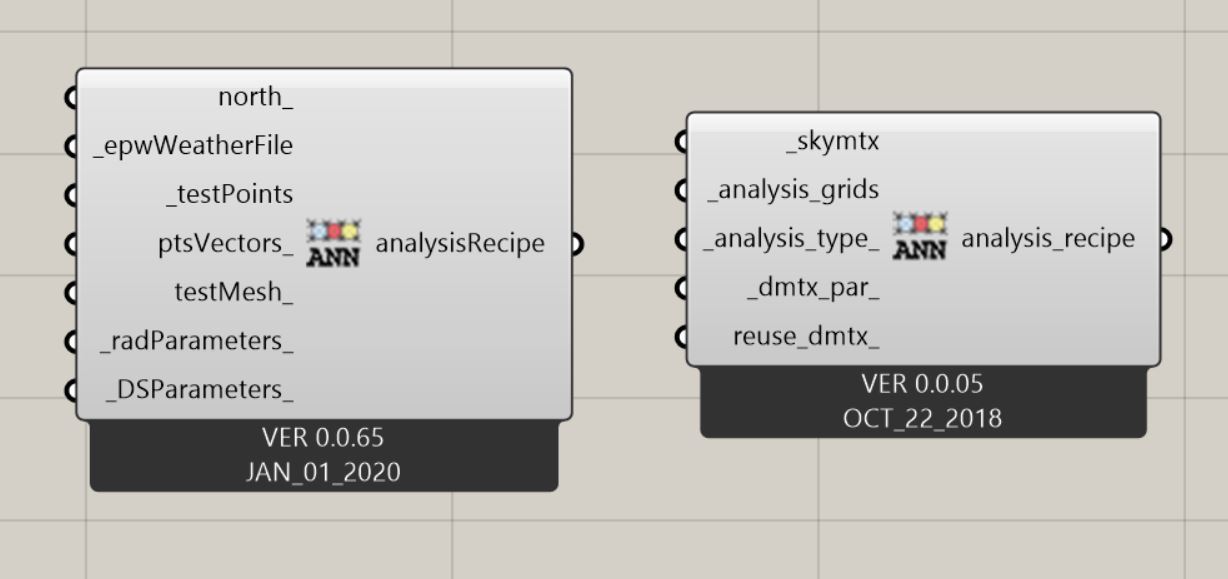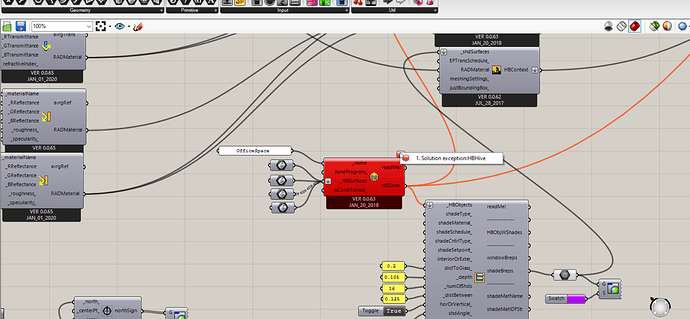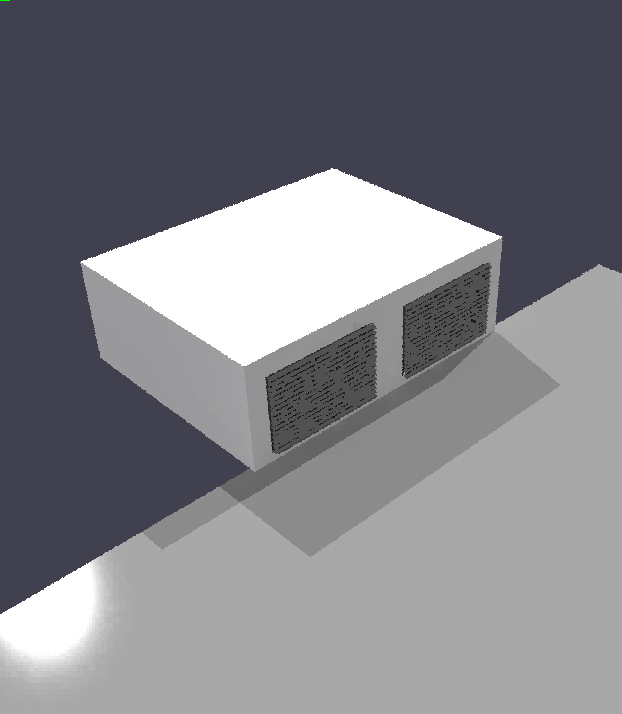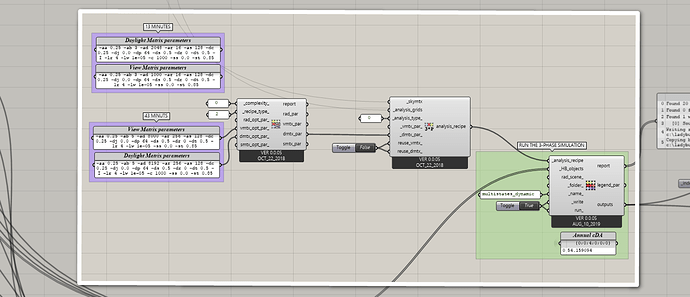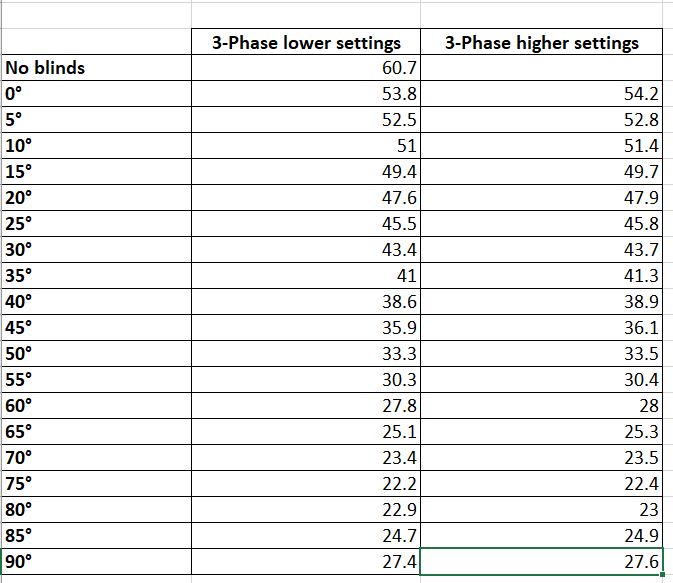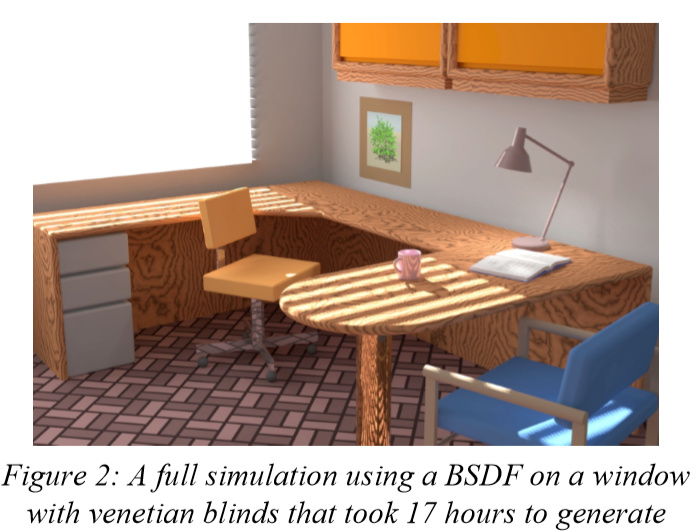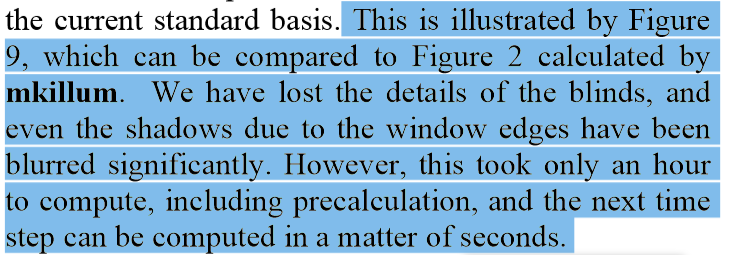Hello everyone ,
I have a query regarding two different recipie for annual daylight simulation. Can anyone explain me the difference between this two recipe as both are used for annual daylight simulation. Does accuracy of values between these two are different?
They are both based on the improved Daylight Coefficient Method. The annual daylight recipe does not support Window Groups and should be running faster than daylight coefficient recipe. Window groups are needed if you are trying to do a proper sDA calculation for LEED v4 and such. If you are just interested in studying illuminance patterns, it is likely more efficient to stick to the annual recipe.
Regards,
Sarith
Hello @sarith,
I have a question regarding the HoneybeePlus_Annual Daylight recipe, considering to have the same geometry and radiance materials settings, is it normal to have higher results compared to a simulation run in honeybee legacy?
Hi @Matteo, well, assuming everything else is the same, it comes down to the calculation settings. The results are expected to be different - not always higher - for instances where you direct sun beam in your space. For overcast sky conditions, the difference should not be too high (say not higher than 20%).
If the difference is high, its likely that you are running the legacy version at lower radParameters than required for your simulation. If you have the time, one way to test out if you are running Daysim (i.e Honeybee Legacy) at optimum settings for your project would be to progressively increase the radparameters and see if you notice any difference in results.
Regards,
Sarith
Thank you @sarith, I would like to ask you one last question related to that, I have run a series of simulation using the same geometry (a simple test box with two windows with Venetian blinds facing south) and Radiance materials, to compare the results using the same methods in HB legacy and HB+. From the results, I can see that the difference is important, but when I add a surface (reflectance 0.2) simulating the terrain in front of the windows, the difference becomes smaller (more or less inside of the 20% range you suggested). The curious fact is that in HB legacy, the addition of this surface makes the results significantly higher, while in HB+ the difference is not so sharp.
Is it due to the fact that the backward ray-tracing method used by Daysim is more influence by this kind of surface while the matrix-method used in HB+ doesn’t?
I would like to understand better what is going on behind, and if the results I am getting make sense for you.
I would be really glad if you could clarify to me this point!
A general heads up regarding whatever version of Honeybee you use: The calculation settings need to be set higher if you include venetian blinds in your simulation as a fair amount of radiation will likely get trapped in the slats and not make it out into the room. In legacy, you need to increase the ambient bounces by at least 3-4, set ambient accuracy to 0.1 or lower, and increase ambient divisions by a factor of at least 2 (set to 2048 if it was 1024 etc). In [+], you should increase the ambient bounces by 3-4 and increase the ambient divisions by a factor of at least 4.
Both Daysim and Honeybee[+] use matrices. The Daylight Coefficient Method, to which we can trace all these simulation approaches, relies on matrix calculations (see section 6.2).
Your plot is very interesting, considering that in the presence of terrain, the values are increasing with Legacy and decreasing with [+]. I am curious as to what exactly is the Radiance geometry and surface properties that get written out in both cases. Can you share the project folders for both instances?
Regards,
Sarith
(PS: It might be a while before I can get to the bottom of this!)
Dear @Matteo,
In HB Legacy, for the Daylight Factor, the ground reflection, is calculated automatically, there should be no need to add it:
Dear @sarith, making comparisons between HB Legacy and HB+, analyzing the daylight factor or annual illuminance (without shadings), I also found that for the same parameters, the result out from HB+ is always greater (I think as you mentioned, about 20%).
In my opinion the discrepancy of 20% is important, so I wanted to ask you, what would you advise to use between the two processes for a “simple” daylight simulation?
Greetings and happy holidays.
L.R.
Hi @LiamRuvio thank you for the information; just to clarify, I am actually comparing the two recipes for annual calculation in the picture and not the DF one. My goal is to run a three-phase annual simulation for dynamic blinds and what I am doing now is to better understand the relation between simulations in Legacy and Plus under the same conditions, before jump to the three-phase.
Best Regards and Happy Easter
Matteo
Hi @sarith and thank you for the interest,
I have attached the two files I am using, Honeybee+ in relatively new for me, I installed it more or less one month ago because I would like to use it to run an annual daylight simulation with dynamic blinds, using the three-phase method as my final goal. Regarding that, I have already created some BSDF materials using WINDOW 7.7 and I think I have understood the workflow to follow (I am going to control the system using a schedule and also take out a light control schedule to feed into an energy simulation, but I think these parts are quite clear to me).
At the same time, I was also comparing the annual calculation between Legacy and Plus and there I met the strange phenomena described in the previous posts.
If you can also have a quick look to see if there are any macroscopic errors it the workflow and especially in the settings of the three-phase would be also great! (the 3-phase in just in the lower part of the canvas in the second file).
Thank you again for your availability Sarith and have nice holidays!
HB_legacy_method.gh (635.6 KB) HBPlus_Method_(and_three-phase).gh (642.4 KB) xml_files.zip (1.3 MB)
Hi @Matteo, I got an error with your gh file.
Can you just share the Radiance folders that get written out in both cases (with legacy and HB[+])?
Regards,
Sarith
Hi @LiamRuvio, I am surprised that the difference between HB legacy and [+] versions are that much for Daylight Factor calculations. They more or less both use the same Radiance workflow and binaries for running the simulation. The workflow is very different for annual calculations as Legacy uses Daysim while [+] uses the new rcontrib-based workflow.
For DF I would recommend sticking to the legacy versions for now (mostly because it has been around for so long and I am assume any kinks, if present, have been worked out over the years).
Regards,
Sarith
Hello @sarith, you can find the folders at this link, I uploaded the files for the 45° blinds for both Legacy and HB[+] and for both the options (with and without the terrain). Hope is what you were searching for!
https://drive.google.com/drive/folders/1yZfA_QA6evu67BSgvCHBAlovw4DjQB7Y?usp=sharing
Hi @Matteo, the folders for legacy are fine but the ones for [+] only contain the ill files. Can you share the entire folder with rad files, bat files etc.?
Hi @sarith, I upload the new folders with everything, there should be fine now!
https://drive.google.com/drive/folders/1yZfA_QA6evu67BSgvCHBAlovw4DjQB7Y?usp=sharing
Hi @Matteo,
A few observations:
-
Terrain or no-terrain: The models without the terrain, referred to as ground plane by John Mardaljevic, will likely give you incorrect results. The below is from Section 2.3.4 of his dissertation. His doctoral work from mid 90s to early 2000s pretty much forms the basis of all Radiance-based daylighting simulations today.
Its been somewhat of a recommended-practice in the past 20 years to always include ground plane in daylighting studies. So, I would strongly recommend focusing on those types of simulations alone. The default ground glow for HB[+] is higher than that for Daysim, so when a terrain is introduced you are seeing lower values for HB[+] and higher for Daysim. I am not sure if that deserves any attention in your thesis/project, because ideally you should always have a local terrain. -
Surface properties of the ground plane: Your ground plane currently has a specular component to it, which is unrealistic in most real-world scenarios (except when you are studying the effect of something like snow). This is your current geometry:
You can see the shiny highlight from source above on the ground. I recommend setting the ground material to something like (void plastic ground 0.2 0.2 0.2 0 0) just so that it is more in line with how a diffusing ground surface actually behaves:
-
Discrepancy between HB[+] and Legacy: As I had mentioned previously, there is a likelihood of Radiation getting trapped in the blinds with low ambient settings. I rendered a sectional view of your geometry on a bright daylighting condition
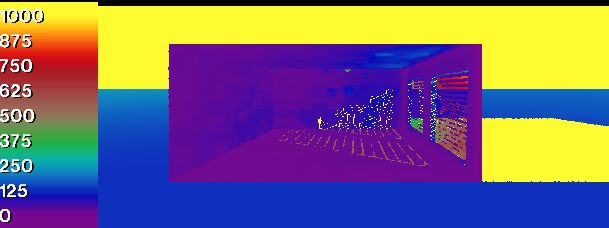
As I had mentioned previously, you need to crank up your ambient calculation settings for both Legacy and [+] simulations (if you are comparing them). Although it might be time consuming, I would test out a few ambient settings to check at what point the results stop changing when the settings are being increased progressively.
Regards,
Sarith
Hello @sarith,
thank you very much for the in-depth analysis you made of my geometry and settings and for all the hints you gave me. These pieces of information are definitely useful to better understand the logic of the program and relevant material for my thesis work.
Have a nice day and thanks again!
Matteo
Hi @sarith,
one last small thing; is it correct to say that in a 3-phase simulation the settings for the receipt component play a smaller role when the geometry of the window and blind is substituted by BSDFs materials coming, for instance, from WINDOW?
Because I tried to change the settings using higher ones but the difference in the results is not relevant (around 0.3%) while the computational time jumps from 13 to 43 minutes.
This is just a curiosity that came to my mind today, answer only if you have time, you have already been too patient with me!
Best,
Matteo
Hi @Matteo
Yes. The computational effort that you’d spend in push rays through the blinds is not required when using Three-Phase as that part is already precalculated and stored in the BSDF file (created through Window or genBSDF). Georg Mischler (schorsch) explains it quiet eloquently in a reply in this thread.. You can see that he is also referring to the ambient parameters that I was referring to in a previous reply of mine.
For a more detailed explanation, you can refer to this paper from 2010. This is before Three-Phase was officially called by that name and was referred to as Dynamic Radiance instead.
It appears that the lower settings that give you a runtime of 13 minutes are sufficient.
Regards,
Sarith
Thank you again @sarith for the clear explanation and for the great job that you and your colleagues do in improving these amazing tools!
Best regards
Matteo

